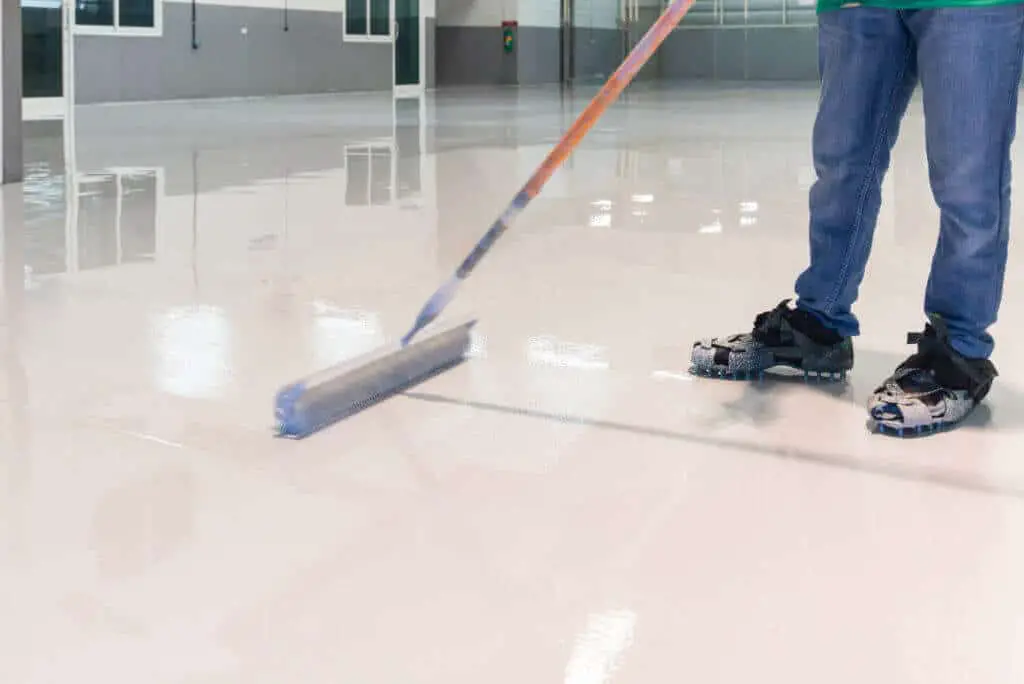Every type of flooring has its disadvantages as well as its advantages, and epoxy flooring is no exception. Although epoxy flooring is considered to be durable, as it is applied over concrete flooring, it is not devoid of disadvantages.
Knowing the disadvantages of epoxy flooring will enable you to consider your chances with the flooring, and this will also prevent you from installing the flooring when it is not suitable for the area you plan on installing it, or if you cannot handle the disadvantages.
The disadvantages of epoxy flooring include its short life span, strong smell, level of sensitivity and it can become dangerously slippery when wet.
Disadvantages of Epoxy Flooring
Table of Contents
Short lifespan
This is one of the major disadvantages of epoxy flooring; it is not a floor on its own and needs to be installed over an already existing floor surface like concrete, wood, or steel. This makes epoxy flooring merely a coat of temporary flooring solution.
This doesn’t necessarily mean the floor won’t last a while in your space; it only means that constant wear and tear takes a significant toll on its lifespan.
Cracks and chips is another problem you will have to deal with, especially if you accidentally drop a heavy object on the floor; this means epoxy flooring is not the best choice of flooring for areas with high impact and traffic like your garage or storage areas.
These cracks may start small, but after a while, they become bigger and cause a large portion of the flooring layer to peel off the floor. This constant wearing out and easily damaged feature of epoxy flooring will require you to frequently install new coats, which is not really budget-friendly.
Strong Smell
When being installed, wet epoxy flooring has a strong ammonia smell, which can be quite offensive as well as toxic.
Read: How to get rid of new carpet smell
If you are applying a dark shade of epoxy flooring, you will have to be prepared to be hit with twice the smell of ammonia compared to lighter shades of the same epoxy flooring, as Darker shades of epoxy have much more hardeners than the lighter shades.
This ammonia fumes can be really toxic and can cause a couple of side effects to anyone near it; this side effect includes lung irritation, nose, eye, and throat inflammation.
Epoxy flooring fumes can be deadly to someone suffering from asthma. Epoxy components are so dangerous that clinical studies have reported it, causing skin cancer in animals.
These components can gain access to your body through lungs, skin, eyes, nose, and throat, and an extensive exposure can cause a series of health issues, and it can also affect your nervous system the same way alcohol would.
If you suffer from respiratory problems or anyone in your household does, then epoxy flooring is a no-no! Although a fully cured epoxy floor poses no potential health risk, so if you have to install an epoxy flooring, it has to be cured properly.
Level Of Sensitivity
Epoxy flooring needs to be installed exactly according to the manufacturer’s instructions. If installed wrongly, the floor covering will not last as long as it should. Scratches appear easily. Epoxy finishing must be applied during that time of the year when the moisture degrees are reduced.
This is since dampness can influence the durability of these flooring. It is recommended to make use of a dehumidifier to reduce humidity for a duration of 24 hours before applying your first layer of epoxy resin.
This will help to remove as much wetness from the air as possible, which will stop damp from coming to be trapped below the floor as soon as the material finish has actually been used.
Application Process
Getting the existing flooring ready for an epoxy flooring installation can be quite tedious. It requires a lot of preparation, and The existing flooring has to be clean and also without any kind of oil or solvents before the epoxy covering can be applied.
Cracks will certainly require to be filled up too. Cleaning up the existing floor requires a lot of effort, which can be a major bummer, especially if you are doing the project yourself.
You have to ensure you get rid of all the moisture trapped inside the existing flooring because installing epoxy flooring over a moisture trap floor can cause buckling, warping, and even bulging on the surface as the flooring material dries and the moisture evaporates.
This can cause you to have to reinstall your epoxy flooring and incur extra costs trying to fix the damage. Applying epoxy flooring over the tiniest particles can lead to cracks in the future; with epoxy flooring, there is no room for mistakes.
Epoxy flooring is Skid Resistant.
This is another red flag for epoxy; it can become dangerously slippery when wet; this is due to the fact that epoxy flooring is a resinous flooring material that is non-porous. This is a serious health hazard for homes with kids, pets, or elderly citizens.
Read: How to make floors less slippery
But if you are really bent on installing epoxy flooring in your home, there are ways you can mitigate the slipperiness, although it may come at an extra cost, they include;
- when installing your epoxy flooring, you can opt for silica sand as the final coating; this helps to create resistance.
- For extra resistance, you can Add an aluminum oxide additive to the epoxy material to get the maxim.
- Adding Shark Grip to the final coating for texturing and adding resistance to the floor.
- Placing containment mats in areas with high traffic
although this extra measure comes at an extra cost, they will help to prevent accidents that can occur otherwise without them.
Removal Of Old Epoxy Flooring
Removing your epoxy flooring is something that might not occur soon after installing, but it would happen either way, so it has to be considered. Removing old epoxy flooring is something that has to be done by a professional as it involves a ton of technical and difficult processes.
To remove an old epoxy flooring requires grinding, so you will need an industrial grinder, which is not a tool everyone has in their toolbox. This means you will have to consider hiring a contractor and a seasoned one at that, as removing an epoxy flooring requires the same carefulness as the installation.
This is because any mistake in the removal procedure will cause damage to the underlying floor, and you will need to pour a new floor. The same qualities that make epoxy flooring desirable are the same things that make it hard to remove.
Read: How hard is it to epoxy a garage floor
Discoloration
Mixing the epoxy can cause the floor coating to become discolored; if you are using multiple kits, there might be color variations due to the various kits, this can cause the epoxy coating to become discolored.
Ultraviolet rays are another leading cause of discoloration; if one batch of epoxy coating sits in the sun for too long than the other, it could lead to different color variations between the two.
Maintenance
Maintaining your epoxy flooring requires special cleaning acids and other chemicals, which can be costly to purchase. You will also need to purchase some special protective gear when working with these chemicals.
The cost of protective eye-wear and breathing gear increases the cost of maintenance and the effort required to install and maintain the floor.
Coldness
Epoxy flooring feels cold underneath your feet, just like tiled floor, but you can undo this by installing an underfloor heating system underneath the floor.
Conclusion
Knowing the disadvantages of epoxy flooring will help broaden your knowledge on epoxy flooring, and you won’t make a flooring decision you will end up regretting when you start experiencing the cons of your newly installed epoxy flooring.
The disadvantages do not make the floor any less beautiful or useful, but they are worth knowing just in case it may have an adverse effect on your health.

